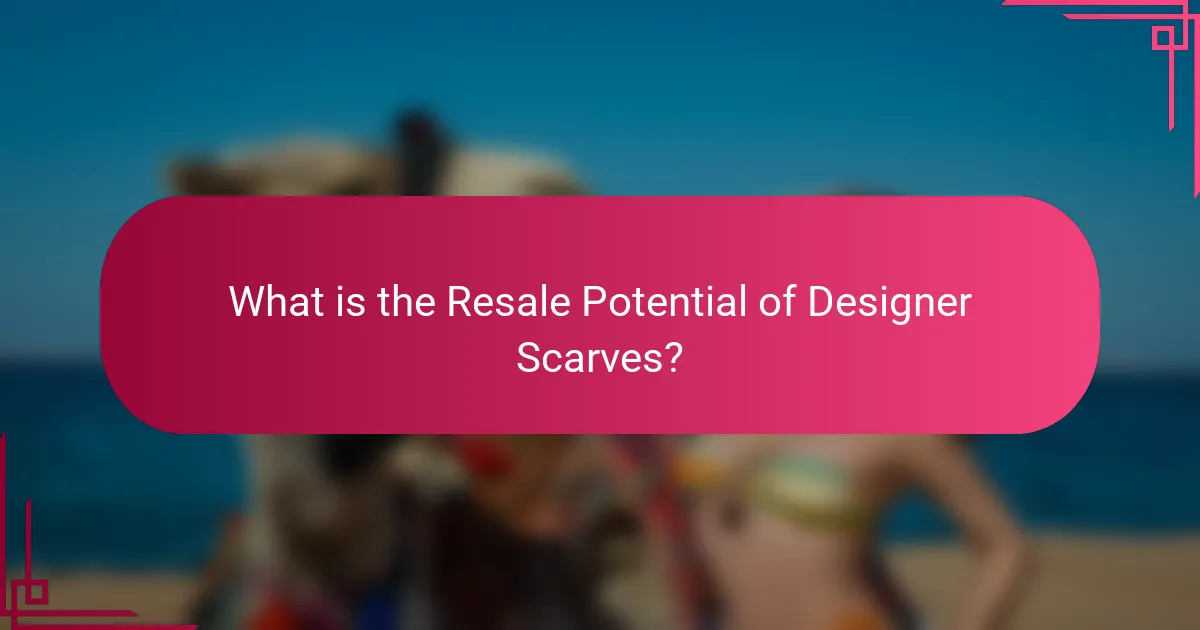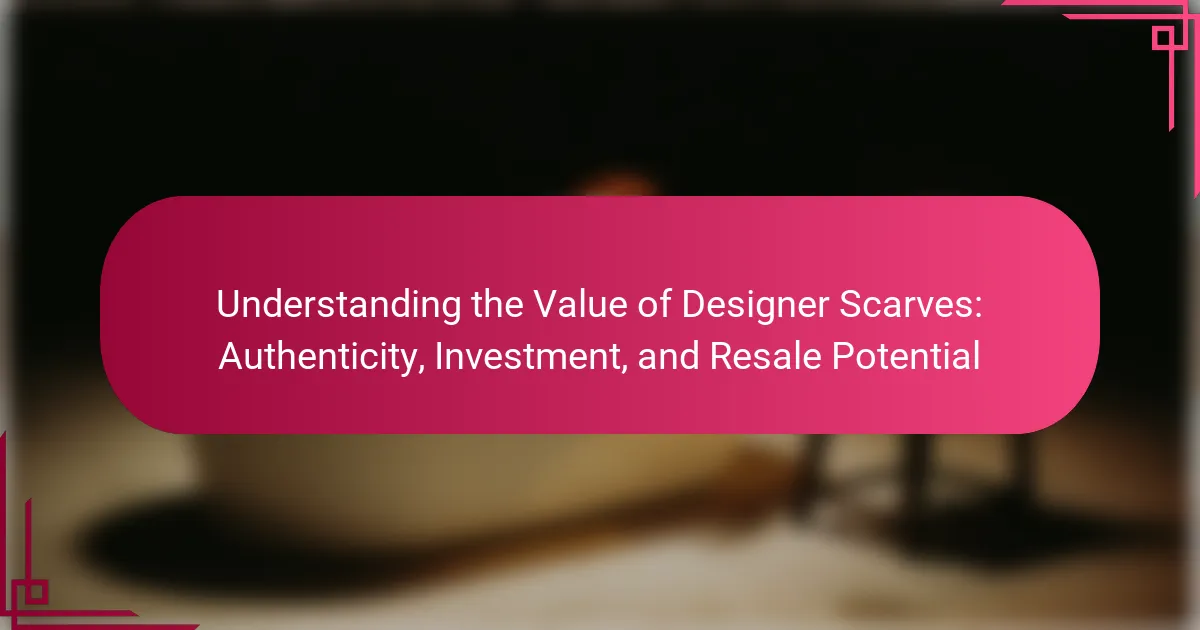Designer scarves are high-quality fashion accessories produced by luxury brands, characterized by unique designs and premium materials. This article explores the value of designer scarves, focusing on aspects such as brand recognition, exclusivity, and craftsmanship that contribute to their appeal. It discusses the strong resale market for these items, highlighting how certain brands like Hermès and Chanel can appreciate in value over time, particularly limited editions and iconic prints. Additionally, the article emphasizes the importance of authenticity and quality when purchasing designer scarves, offering insights into the factors that influence their resale potential and overall investment value.

What are Designer Scarves and Why Are They Valuable?
Designer scarves are high-quality, fashion accessories created by luxury brands. They often feature unique designs, premium materials, and craftsmanship. The value of designer scarves comes from their brand recognition, exclusivity, and artistic appeal. Scarves from renowned designers like Hermes or Chanel can appreciate in value over time. The resale market for these items is strong, with some pieces fetching prices significantly above their original retail cost. Collectors often seek out limited editions or iconic prints, further driving demand. Additionally, the versatility of designer scarves allows them to be styled in various ways, enhancing their appeal.
How do Designer Scarves differ from Regular Scarves?
Designer scarves differ from regular scarves primarily in quality, brand recognition, and price. Designer scarves are often made from premium materials, such as silk or cashmere, ensuring superior durability and comfort. In contrast, regular scarves may use synthetic or lower-quality fabrics.
Brand recognition plays a significant role in differentiating these scarves. Designer scarves are produced by well-known fashion houses, which adds prestige and status. Regular scarves typically lack this brand association, resulting in lower perceived value.
Price is another key difference. Designer scarves can range from hundreds to thousands of dollars, reflecting their craftsmanship and brand reputation. Regular scarves are generally more affordable, often priced under $100.
Additionally, designer scarves may feature unique designs or limited editions, enhancing their exclusivity. Regular scarves usually follow more conventional patterns and styles.
The resale potential for designer scarves is often higher due to their brand value and demand in the luxury market. Regular scarves typically do not hold their value as well in resale scenarios.
What attributes define the quality of a Designer Scarf?
The quality of a Designer Scarf is defined by its material, craftsmanship, design, brand reputation, and uniqueness. High-quality materials include silk, cashmere, or fine wool. Craftsmanship involves precise stitching and finishing techniques. The design should reflect creativity and trend relevance. Brand reputation is crucial; established brands usually signify quality. Uniqueness can be found in limited editions or exclusive patterns. Together, these attributes ensure the scarf’s overall value and desirability in the market.
Why is brand reputation important in the value of Designer Scarves?
Brand reputation significantly impacts the value of designer scarves. A strong brand reputation indicates quality and craftsmanship. Consumers often associate reputable brands with luxury and exclusivity. This association enhances perceived value and desirability. High demand for scarves from reputable brands leads to better resale potential. Research shows that items from well-regarded brands retain value over time. For instance, a study by the Luxury Institute found that brand reputation can increase resale prices by up to 30%. Therefore, brand reputation is crucial in determining the overall value of designer scarves.
What factors contribute to the authenticity of Designer Scarves?
The authenticity of designer scarves is determined by several key factors. First, the brand’s reputation plays a significant role. Established luxury brands have strict quality control measures. Second, the materials used are crucial. Authentic scarves are made from high-quality fabrics like silk or cashmere. Third, craftsmanship is essential. Genuine designer scarves feature precise stitching and finishing. Fourth, the presence of labels and tags can indicate authenticity. These should include brand logos and care instructions. Fifth, unique design elements are often present in authentic items. These can include limited edition prints or exclusive patterns. Lastly, provenance is important. Documentation of purchase history can validate authenticity.
How can consumers verify the authenticity of a Designer Scarf?
Consumers can verify the authenticity of a designer scarf by examining specific details. First, check the brand’s logo and stitching. Authentic scarves feature precise logos and high-quality stitching. Next, inspect the material. Genuine designer scarves use premium fabrics like silk or cashmere. Additionally, look for tags and care labels. These should include brand information and care instructions.
Furthermore, research the specific model. Authentic scarves often have unique identifiers or patterns associated with the brand. Compare prices from reputable retailers. If a deal seems too good to be true, it likely is. Finally, consider obtaining a certificate of authenticity. Many high-end brands provide this documentation.
What are the consequences of purchasing counterfeit Designer Scarves?
Purchasing counterfeit designer scarves leads to legal and financial consequences. Consumers may face legal action for trademark infringement. Counterfeit products often lack quality, resulting in rapid wear and tear. Buyers may also lose money, as counterfeit scarves have no resale value. Additionally, purchasing counterfeit items supports illegal trade and exploitation. This undermines the authenticity of luxury brands. Research indicates that counterfeit goods cost the global economy billions annually. In 2020, the International Chamber of Commerce estimated losses at $1.8 trillion due to counterfeiting.
Why should Designer Scarves be considered an investment?
Designer scarves should be considered an investment due to their potential for appreciation in value. High-end fashion items, like designer scarves, often retain or increase their worth over time. The luxury fashion market has shown consistent growth, with certain brands experiencing significant resale value. For example, Hermes scarves can appreciate by up to 20% annually. Additionally, the limited availability of certain designs creates scarcity, further boosting their investment potential. Collectors often seek out iconic pieces, leading to competitive bidding in resale markets. Investing in designer scarves combines aesthetic enjoyment with financial gain opportunities.
What historical trends show the investment potential of Designer Scarves?
Designer scarves have demonstrated significant investment potential over the years. Historical data indicates that the resale value of iconic designer scarves has increased consistently. For instance, Hermès scarves often appreciate by 20% to 30% annually. Auction results from platforms like Christie’s show that rare pieces can sell for several times their original retail price. The demand for limited edition designs has also surged, reflecting collectors’ interest. Furthermore, fashion trends have shifted towards sustainable luxury, enhancing the appeal of high-quality accessories like designer scarves. This trend suggests a growing market for investment in fashion items that retain value over time.
How do market demand and rarity affect the value of Designer Scarves?
Market demand and rarity significantly influence the value of designer scarves. High market demand increases the price as more consumers seek limited-edition or exclusive designs. Scarves that are rare or produced in limited quantities often command higher prices due to their scarcity. For example, a designer scarf released as a limited collection can appreciate in value over time. This phenomenon is supported by the luxury market trend, where items with high demand and low supply tend to see price increases. Additionally, resale platforms often reflect this dynamic, with rare scarves fetching much higher prices than more common counterparts.

What is the Resale Potential of Designer Scarves?
The resale potential of designer scarves is generally high. Popular brands like Hermès and Chanel often retain or even increase their value over time. Scarves made from high-quality materials and limited editions tend to perform better in the resale market. According to a 2021 report by The RealReal, luxury accessories, including scarves, saw a 25% increase in resale value. Scarves in excellent condition with original packaging command higher prices. Scarves featuring iconic designs or collaborations also attract collectors. Overall, the market for designer scarves remains robust, driven by demand for luxury fashion items.
How does the condition of a Designer Scarf impact its resale value?
The condition of a Designer Scarf significantly impacts its resale value. Scarves in excellent condition retain higher value due to their desirability. Signs of wear, such as stains or fraying, decrease the resale price. Scarves with original packaging and tags also command better prices. A study by The RealReal indicates that items rated “like new” can sell for up to 70% of their retail price. In contrast, items rated “good” or “fair” can drop to 30% or less. Thus, the better the condition, the higher the potential resale value.
What maintenance practices can preserve the value of Designer Scarves?
Regular cleaning and proper storage are essential maintenance practices that preserve the value of designer scarves. Cleaning should be done according to the manufacturer’s instructions, often requiring gentle hand washing or dry cleaning. Avoid using harsh chemicals that can damage the fabric.
Storage should take place in a cool, dry place away from direct sunlight. Folding scarves neatly or rolling them can prevent creasing. Using acid-free tissue paper can help maintain their shape and prevent color fading.
Additionally, avoid wearing scarves in harsh weather conditions. Extreme heat or moisture can degrade the fabric quality over time. Regularly inspecting for signs of wear or damage allows for timely repairs, further preserving their value.
How do seasonal trends affect the resale market for Designer Scarves?
Seasonal trends significantly influence the resale market for designer scarves. During colder months, demand for scarves increases, leading to higher resale prices. Scarves are often marketed as seasonal fashion items, impacting consumer interest. For instance, winter collections tend to sell out quickly, creating scarcity in the resale market. In contrast, warmer months see a decline in demand, resulting in lower resale values. Seasonal fashion cycles dictate which styles are popular, affecting resale trends. Scarves featuring seasonal colors and patterns often see better resale performance. Data from resale platforms show that scarves listed during peak seasons sell faster. Overall, seasonal trends play a crucial role in determining the resale value of designer scarves.
What platforms are best for reselling Designer Scarves?
The best platforms for reselling designer scarves include Poshmark, Depop, and The RealReal. Poshmark is user-friendly and has a large audience for fashion items. Depop attracts a younger demographic and emphasizes unique styles. The RealReal focuses on luxury items and ensures authenticity through expert verification. Each platform provides a different audience and selling experience.
How do fees and commissions vary across different resale platforms?
Fees and commissions vary significantly across different resale platforms. Some platforms charge a flat fee per sale, while others take a percentage of the sale price. For instance, Poshmark typically charges a $2.95 fee for sales under $15 and a 20% commission on sales above that amount. eBay, on the other hand, usually charges a 10-12% final value fee based on the total selling price. Depop has a 10% fee on sales, while Mercari charges a 10% commission as well. These differences can impact sellers’ profits and pricing strategies. Understanding these fee structures is crucial for maximizing returns when selling designer scarves.
What strategies can maximize profit when reselling Designer Scarves?
To maximize profit when reselling designer scarves, focus on sourcing authentic products at lower prices. Research market trends to identify popular brands and styles. Utilize online platforms with high traffic for listings, such as eBay or Poshmark. High-quality photographs and detailed descriptions enhance appeal. Engage with potential buyers through social media to build a loyal customer base. Timing sales during peak seasons can increase demand and prices. Offer bundle deals or discounts for repeat customers to encourage bulk purchases. According to a study by ThredUp, resale value can increase by 20% when items are marketed effectively.

What are the Best Practices for Purchasing Designer Scarves?
Research the brand’s reputation before purchasing designer scarves. Authenticity is crucial for value retention. Verify if the seller is authorized or reputable. Inspect the scarf for quality and craftsmanship. Look for details like stitching and fabric type. Check for original tags and packaging. Compare prices across different retailers to ensure fair pricing. Consider the scarf’s versatility for styling options.
How can consumers identify reputable sellers of Designer Scarves?
Consumers can identify reputable sellers of designer scarves by checking for authenticity certifications. Reputable sellers often provide proof of authenticity from the brand. They may also offer a return policy, which indicates confidence in their products. Additionally, consumers should look for online reviews and ratings from previous customers. A strong social media presence can also signal a trustworthy seller. Established sellers often have a professional website and transparent contact information. Engaging with sellers through customer service can reveal their reliability. Lastly, familiarity with the brand’s pricing can help consumers spot potential counterfeit products.
What questions should buyers ask when purchasing a Designer Scarf?
Buyers should ask about the authenticity of the designer scarf. They should inquire if the scarf comes with a certificate of authenticity. Buyers should also ask about the materials used in the scarf. Understanding the fabric can indicate quality and durability. It is important to know the brand’s reputation for craftsmanship. Buyers should inquire about the scarf’s care instructions to maintain its condition. Asking about the return policy is also crucial in case of dissatisfaction. Finally, buyers should consider the resale potential of the scarf in the future. Research shows that certain designer scarves retain value over time, making them a worthwhile investment.
How can buyers avoid common pitfalls in the Designer Scarf market?
Buyers can avoid common pitfalls in the Designer Scarf market by researching brands and verifying authenticity. Understanding the difference between authentic and counterfeit items is crucial. Buyers should always check for brand tags, stitching quality, and material. Familiarizing themselves with typical price ranges helps identify potential scams. Seeking reputable sellers, such as authorized boutiques or established online platforms, reduces risk. Reading customer reviews provides insights into seller reliability. Additionally, buyers should ask for detailed product descriptions and images before purchasing. Engaging in these practices minimizes the likelihood of making costly mistakes.
What tips can help buyers make informed decisions about Designer Scarves?
Buyers can make informed decisions about designer scarves by researching brand authenticity. Understanding the difference between authentic and counterfeit products is crucial. Check for quality materials, stitching, and brand tags. Familiarize yourself with the brand’s signature patterns and styles.
Additionally, consider the resale value of the scarf. Some brands retain their value better than others. Review recent sales on platforms like eBay or consignment shops for price comparisons.
Lastly, seek reviews and testimonials from previous buyers. This feedback can provide insights into the product’s quality and the seller’s reliability.
How can buyers assess the long-term value of a Designer Scarf?
Buyers can assess the long-term value of a designer scarf by evaluating its brand reputation, material quality, and rarity. Established luxury brands often retain value over time. High-quality materials, such as silk or cashmere, contribute to durability and desirability. Limited edition or rare designs are more likely to appreciate in value. Buyers should also consider the scarf’s condition and provenance, as these factors affect resale potential. Historical sales data from auction houses can provide insights into market trends for specific brands and styles. By analyzing these attributes, buyers can make informed decisions about their investment in a designer scarf.
What resources are available for learning more about Designer Scarves?
Books on fashion design and textile studies provide in-depth knowledge about designer scarves. Notable titles include “Fashion Accessories: The Complete 20th Century Sourcebook” and “The Fashion Handbook.” Online platforms like Coursera and Udemy offer courses on fashion history and accessory design. Websites such as Vogue and The Business of Fashion feature articles on trends and designer insights. Additionally, social media platforms like Instagram showcase designers and influencers, providing real-time updates. Fashion museums often have exhibitions focusing on accessories, including scarves, offering firsthand experience.
Designer scarves are high-quality fashion accessories crafted by luxury brands, characterized by unique designs, premium materials, and exceptional craftsmanship. This article explores the value of designer scarves, emphasizing their authenticity, investment potential, and resale opportunities. Key topics include the differences between designer and regular scarves, the importance of brand reputation, factors affecting authenticity, and strategies for verifying and maintaining value. Additionally, it examines market demand, rarity, and seasonal trends that influence resale potential, providing insights into best practices for purchasing and reselling designer scarves.
